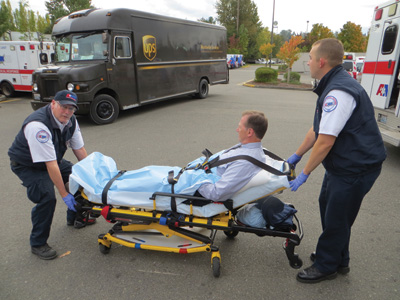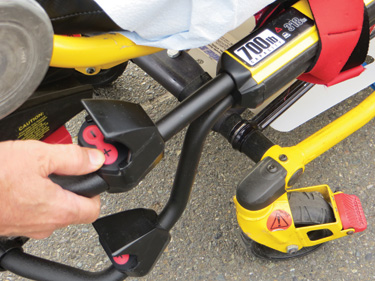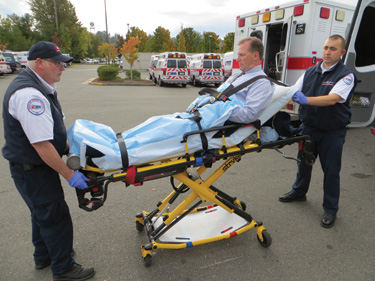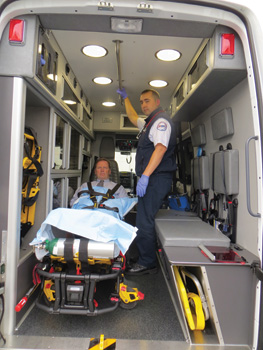By Raul A. Angulo
Whether your fire department is responsible for emergency medical services (EMS) in your community or you partner with another agency, chances are that first responders, emergency medical technicians (EMTs), and firefighters are involved in patient packaging and transport. If you have been in emergency services as long I have (35 years), you don’t need a scientific study to confirm that back injuries are toward the top of the list for on-duty, time-loss injuries.
Think about what goes into responding to an EMS call regarding the EMTs’ physical motor functions. On arrival, they start by bending and twisting the spine while removing all the necessary medical equipment from the apparatus, which may or may not include the gurney at that point. Then they have to carry all that equipment over long distances, up or down stairs, and sometimes over rough terrain just to reach the patient. In addition, when dealing with nonambulatory patients, EMTs have to lower the gurney, bend over, lift, carry, twist, and load the patient on to the gurney.
This action often takes place in tight quarters where personnel don’t have the best posture to employ proper lifting techniques. Then they have to lift a patient-loaded gurney and reverse the sequence back to the ambulance. On arrival at the ER, the EMTs have to remove the patient-loaded gurney from the ambulance and transfer the patient to a hospital gurney. This action can be repeated several times throughout the work shift and eventually takes its toll on the body. How many injury forms come up to the supervisor with “while lifting patient onto gurney, I strained my lower back” listed for cause of injury?
 |
| (1) The Power-PRO XT is the newest ambulance cot from Stryker EMS. The gurney is a powerful battery-powered hydraulic patient lifting and lowering system. This gurney is engineered to reduce spinal load injuries and increase the safety margin for EMTs during patient transfer. (Photos by author.) |
Spinal Loading
Injuries within the fire service and EMS have been generally classified under the acute (single-incident) model. For example, the acute model would attribute a typical lower back injury to a single overexertion event. This model is typically applied to individuals who experience minimal spinal loading on the job. However, ergonomic studies have proven that medics in the EMS field experience frequent spinal loading because of repetitive motions such as lifting, lowering, carrying, loading, and bending. For this reason, injuries in the EMS field should be classified under the cumulative model, which considers injuries from frequent exertion and fatigue failure over time.
In a Western Michigan University study by Tyco K. Fredericks, Steven E. Butt, and Ashley Hovenkamp titled, “The Impact of Gurney Design on EMS Personnel,” a four-year test was conducted with a Northern California EMS provider. During the first two years, the EMS company used gurneys that required EMTs to lift and lower patients manually. During the third and fourth years, the company replaced the manual gurneys with a fleet of battery-powered hydraulic gurneys that can be raised and lowered using an activation power switch.
 |
| (2) The maneuver of manually lifting an adult patient in a standard gurney is responsible for the majority of lower lumbar back injuries. The Power-Pro XT, which can be lowered to14 inches, virtually eliminates this this risk by letting the SMRT Pak Power System hydraulically do all the lifting with the touch of a finger. |
Test Results
During the first two years, manually-operated gurney operations resulted in claims totaling $88,453 with 208 lost work days and 478 days of nonphysical modified duty. After using the battery-powered hydraulic gurneys for the last two years of the test, claims fell to $51,870 with 66 lost work days and 278 days of modified duty. There is also a huge savings in overtime backfill costs, which wasn’t part of the study but goes without saying.
There was a dramatic decrease in injury incidents specifically related to raising and lowering the gurney. The total claims associated with raising and lowering the gurney decreased from $42,114 to $3,412. In fact, 52 percent of the cost savings specifically associated with loading incidents occurred in that first month after the new gurneys were installed. The ergonomic improvement to the raising and lowering mechanisms of the gurney resulted in an overall claims savings of 92 percent in the two years after installing the battery-powered hydraulic gurney compared to the two years prior to its installation.
There are more specifics to the study, but these are the highlights to demonstrate how mechanical advances in emergency equipment can be safer for your employees by looking out for their well-being and extending their career longevity. It is safer for the patient and allows better care. Finally, positive financial impacts for the organization are dramatically realized.
 |
| (3) This gurney weighs 125 pounds but with the touch of a button has a lifting and weight capacity of 700 pounds. The wheels are two inches wide and six inches in diameter, allowing the gurney to be pushed over rugged terrain with minimal effort. The swivels allow for 360-degree maneuverability. The four wheel locks hold the gurney securely in place during patient packaging. |
A Gurney to Reduce Spinal Load Injuries
To remain competitive, Stryker EMS constantly reviews the causes of injuries in the EMS field to develop products that reduce spinal load injuries and increase the margin of safety for EMTs. The Power-PRO™ XT ambulance cot is a gurney equipped with features that keep a paramedic’s spinal load low, which in turn extends his fatigue limit, reduces the risk of injury, and extends his career longevity. The Power-PRO XT battery-powered hydraulic system raises and lowers the patient-loaded gurney with the touch of a button. It has a 700-pound weight capacity, which accommodates the majority of patients encountered in the field.
Transferring a heavy person onto the gurney remains challenging, but once the patient is supine and strapped into the ambulance cot, simply pushing the raise button hydraulically elevates the gurney 3½ feet (41.5 inches) to its highest position. Even the most petite EMT can raise a 500-pound patient using a pinky finger instead of back muscles. It virtually eliminates the need to manually and physically lift or lower a patient-loaded gurney by emergency personnel. That’s the feature that caught my attention because in my opinion that’s where the majority of disability time-loss injuries occur during an EMS incident. It’s happened to me!
The SMRT Battery Pak Power System is the energy and muscle behind this marine-grade hydraulic lifting system. The fast-charging, all-weather, sealed battery is crash-tested for toughness and reenergizes to a full charge in approximately two hours. The batteries have zero memory, so repeated partial charges don’t diminish the SMRT Pak’s lifespan or power reserve. The SMRT charger automatically evaluates each battery’s condition and cannot overcharge or overheat. The auto-power management system (power-saver) extends battery life, and power level indicator lights keep the EMTs informed of the power status. A flashing amber light indicates when it’s time to switch out the SMRT Pak.
 |
| (4) With the push of a button, the SMRT Pak Power system raises the patient-loaded gurney to its maximum height of 41.5 inches. EMTs merely guide the gurney to the raised position. This mechanical advantage reduces spinal load and prevents injuries for personnel, saving thousands of dollars in related disability claims and overtime backfill. The X-frame is designed so it will not accidentally “hot drop” a patient. |
An in-fastener shutoff is a power safety feature that automatically disables the cot when it is locked inside the ambulance. Deenergizing the gurney prevents it from accidentally being raised inside the ambulance with a patient if the raise button is accidentally bumped.
Safety Features
There are numerous operational and safety features for the EMT and the patient. An hour meter indicates how many hours the cot has been in service for preventive maintenance purposes. The rugged, oversized swivel wheels are two inches wide and six inches in diameter. That means less roll force, 360-degree rotation, and improved maneuverability over rough terrain. There’s a retractable head section and back rest, which has a zero- to 70-degree range of motion. This allows the cot to be maneuvered through tight spaces and small elevators. The leg portion of the bed can be flat or raised to the shock position of +15 degrees or a position of 30 degrees where the legs are raised and supported at the knee joint.
The folding side rails and hand grips have a textured nonskip surface for maximum control. The safety pull bar and release mechanisms are designed to keep hands and fingers away from any moving parts to reduce the risk of getting caught or pinched. It is also designed to not accidentally “hot drop” a patient when loaded. That’s an excellent feature, because I have also witnessed that embarrassing event, and it can lead to additional patient injury and a lawsuit.
Cases in Point
The Ambulance Transfer and Emergency Care Company (A-TEC), of DeKalb, Illinois, purchased six Power-PRO ambulance cots and one Stair-PRO® stair chair in December 2005. The company realized a reduction of personnel injuries from nine in 2005 to zero in 2007. That should impress any city risk manager and finance director. It should also impress any supervisor or company officer whose number one job is to watch out for the safety of his crew. Although this 125-pound unit weighs more than a standard gurney, it makes up for it when it’s time to lift some real weight. EMTs are not getting injured lifting a 125-pound patient.
American Medical Response (AMR), the largest ambulance provider in the nation, works very closely with the Seattle (WA) Fire Department and Medic One. Our paramedics handle all the advanced life support (ALS) transports within the City of Seattle and AMR handles all the basic life support (BLS) transports, so we work together numerous times throughout a 24-hour shift. This is where I got my first look at the Stryker Power-PRO XT. When I saw the ease in lifting a patient-loaded gurney, I immediately noticed the back-saving benefits and thought this is something we desperately needed in the Seattle Fire Department. But, the reality is, like most cities, much of our equipment is purchased from the lowest bid and these “beefy boys” looked like high-ticket items.
Brant Butte, director of communications for AMR Seattle, provides a background on the driving force behind switching to the Stryker gurney. “AMR Seattle is constantly trying to identify risks and practices that can lead to personnel injuries. If we can identify them, then we can prevent them. After reviewing studies that came out from Fairfield County and Charleston County, South Carolina, A-TEC, and Century Ambulance and comparing them with our internal data, the cost savings in switching over to the Stryker Power-PRO XT was a ‘no brainer.’ We would recoup the investment in a couple of years if not sooner.
 |
| (5) The back rest has an articulating range of motion from zero to 73 degrees. The gurney can be loaded in the shock position of +15 degrees and has a position that can support the legs at the knee joint raised to 30 degrees. An in-fastener shutoff is a power safety feature that deenergizes the gurney when it is bedded and secured inside the ambulance. This prevents the gurney from accidentally raising the patient. |
“These are state-of-the-art gurneys and they’re not cheap. But, you get what you pay for. If this expensive piece of equipment reduces employee and patient injuries, then all the related costs, including liability, offset the purchase. We want our people to have full and rewarding careers. Employee morale and commitment goes up when the company invests in the best equipment available to keep staff from being injured on the job. Employees also take better care of the equipment, which reduces repair costs. Having high standards for training and equipment helps with employee retention and recruitment, and that’s a win-win for our EMTs and AMR,” Butte adds.
There is a handy calculator on the Stryker Web site (www.ems.stryker.com). By typing in the estimated number of patients transported per shift, it calculates how much weight the Power-PRO XL can save your crew from lifting per shift. Obviously, less cumulative weight moved means fewer injuries and related costs. $12,000 per unit is a hefty price tag, but fleet rates and leasing options are available through Stryker EMS. Before risk managers and finance directors shy away from the price, consider the saying, “Pay me now, or pay me later.”
RAUL A. ANGULO, a veteran of the Seattle (WA) Fire Department and captain of Ladder Company 6, has more than 30 years in the fire service. He is a member of the Fire Apparatus & Emergency Equipment editorial advisory board. He lectures on fire service leadership, company officer development, and fireground strategy and accountability throughout the United States, Canada, and Mexico.

